Uttrakhand
About Uttrakhand
Land of untouched natural beauty and spirituality, Uttarakhand is a Himalayan state of North India, famously known as Devbhumi (or the Land of the Gods). Carved out from Uttar Pradesh, the state, formerly known as Uttaranchal, is a place that not only boasts of a scintillating view of the Himalayas but also exhibits a cultural ethos which speaks of a harmonic coexistence with nature.
Uttarakhand is a popular pilgrimage site, as it is the originating spot of the Ganga and the Yamuna, two of the most sacred rivers for Hindus. Uttarakhand is home to the Char Dhams, the four most holy sites of pilgrimage revered by the Hindus – Gangotri, Yamunotri, Kedarnath, and Badrinath. With oaks, birches, silver firs and rhododendrons adorning the steep mountain slopes, Uttarakhand offers you a glimpse into an untainted and idyllic world.
Nainital
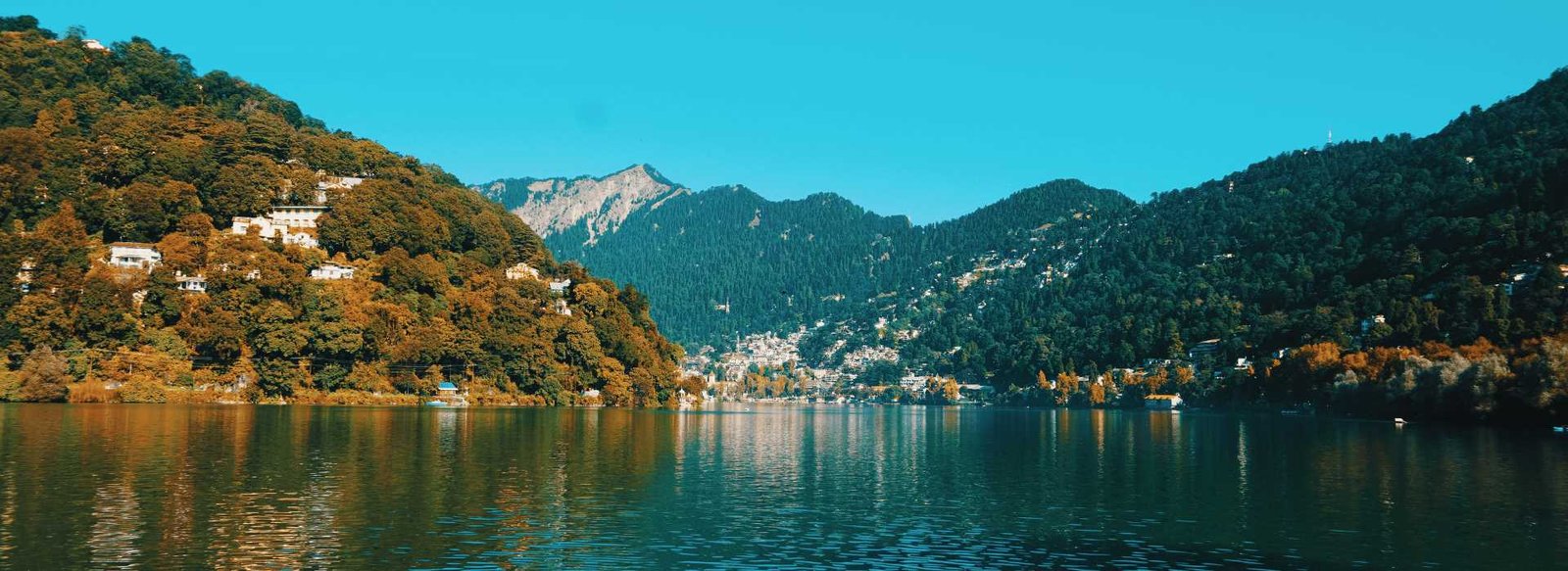
The gem of Uttarakhand – Nainital is a charming hill station that sits prettily at the green foothills of the Kumaon ranges in the Himalayas. Located at an elevation of around 1938 metres, Nainital is located and developed around the beautiful Naini Lake, after which the town is named. The most visited hill station in North India, Nainital is a perfect weekend getaway from the Indian capital of Delhi and the nearby places.
Founded by the British due to its resemblance to the Cumbrian Lake District, Nainital brims with elegant colonial structures that amplify the beauty of this place. It experiences a pleasant climate throughout the year, making Nainital a tourist getaway, especially preferred by families and honeymooners.
Whether you want to go boating on the beautiful Naini Lake, relish some local delicacies, shop at the Tibetan Market and Mall Road, or take a ropeway ride to soak in the beauty of the Himalayas from Snow View Point, Nainital is sure to leave an imprint on you that will last a lifetime.
Naini Lake
Situated in the centre of Nainital, Naini Lake (short for Nainital Lake) is a beautiful natural fresh body lake. The lake is in crescent or kidney shape and is one of the most famous lakes of the Kumaon region. Bounded by Naini Peak on North West, Tiffin Point on the South West and snow-capped peaks on the north, the Nainital Lake offers a breathtaking view, especially during early morning and sunset. It is most famous for boating, picnic and evening walk.
The Nainital Lake is a charming beauty that is surrounded by seven different peaks namely Ayarpata, Deopata, Handi Bandi, Cheena Peak, Alma, Laria Kanta and Sher Ka Danda. The lake itself can be divided into two distinct sections, the northern part called Mallital and southern region called Tallital. Coniferous trees that cover the hillside add charm to the raw beauty of the place. You can also visit Naina Devi Temple on the shores of the lake. A pretty lake that once a European man fell in love with, Naini Lake today serves as a major tourist spot for people from all over the country.
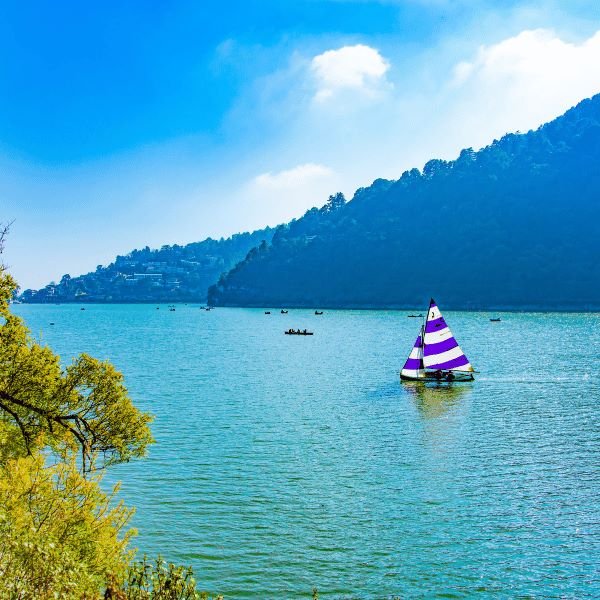

Eco Cave Gardens
Famous for its interconnected rocky caves, hanging gardens and the musical fountain, the Eco Garden are a set of six small caves in the shape of various animals. Located in the Mallital area of Nainital, you need to crawl your way in. In the evenings, you can see the spectacle of the musical fountain with various audio video effects.
The Eco Cave Garden is set up to give tourists a glimpse of the natural habitat of the Himalayan Wildlife by constructing different caves for different animals, similar to their natural home. Lit with petroleum lamps, the most popular caves are Tiger Cave, Panther Cave, Apes Cave, Bat Cave and Flying Fox Cave. Visiting Eco Cave Garden is not recommended for old people and toddlers.
Mall Road, Nainital
The Mall Road of Nainital, which runs parallel to the Naini Lake, connecting the two ends of the hill town (Mallital and Tallital), is the prime shopping, food and cultural centre of the wonder that is Nainital. Whether it is digging into some luscious food or shopping for the cutest local woollens that are to be found, Mall Road is your go-to for it all.
Officially named as Govind Ballabh Pant Marg, the Mall Road in Nainital was built by the Britishers. Today, the road is synonymous to the town of Nainital. You can see unwary tourists taking a stroll at Mall Road at all times of the day. Entry to heavy vehicles and traffic is prohibited during the peak season of May, June and October.
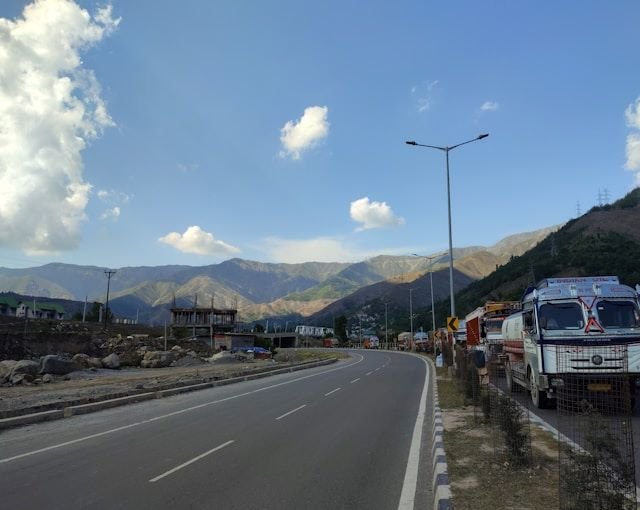

Nanda Devi Temple
Naina Devi Temple located in Nainital is a famous Hindu pilgrimage site and one of the fifty-one Shakti Peethas in India. The presiding deity of the Naina Devi Temple is Maa Naina Devi or Mata Sati. According to Hindu mythology, the temple is built on the spot where Goddess Sati’s eyes fell when Lord Vishnu cut her body into 51 different parts.
Inside the Naina Devi Temple, you will find the two eyes on the roof, depicting Goddess Naina Devi, placed in the centre; with the statues of Goddess Kali and Lord Ganesha surrounding it. The city of Nainital got its name from the Naina Devi Temple. As you climb the hill to reach the temple, various shops selling prasad and other essential puja items will greet you on the way.
Snow View Point
Snow View Point in Nainital stands at a dizzying altitude of 2270 meters above sea level and is one of the most attractive tourist spots of the area. As the name suggests, Snow View Point offers a panoramic view of the mighty Himalayas draped in a blanket of milky-white snow. One can see a picturesque view of all three important peaks- Nanda Devi, Trishul and Nanda Kot peaks together from this point.
A huge pair of binoculars has been installed at the Snow View Point that allows you to take a closer look at the Himalayan range and its magical peaks. If you look closer, you will find a small temple housing the images of Ram, Sita, Laxman, Hanuman with Durga and Shiva. An aerial cable car connects you to the Snow View Point directly from the Mall Road of Mallital and shows you a spectacular view of the beautiful town.
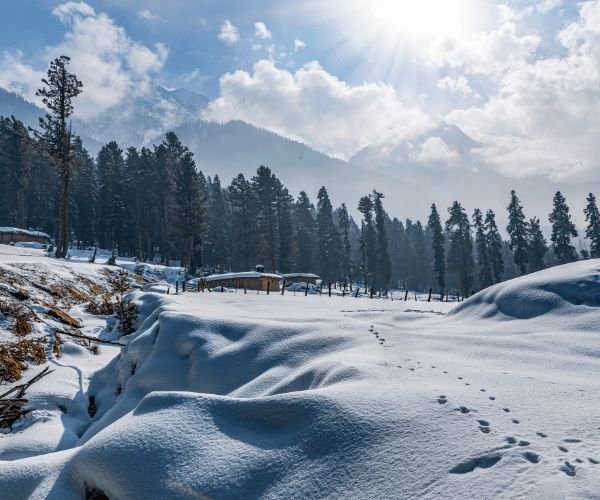
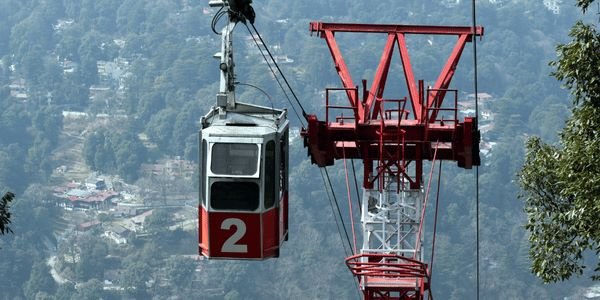
Nainital Rope Way
Nainital Ropeway or the Cable Car Ride is the most popular tourist attraction in the city of Nainital and touted as one of the fastest ropeways in the country. The aerial ropeway connects Mallital to the Snow viewpoint- from the base to a height of 2270 metres. The aerial trip hovering over the Naini Lake and the valley offer panoramic views of the breathtaking landscape. The stunning Nainital ropeway covers half a mile distance in about 3 minutes with 2 trolleys accommodating around 11 people in total at a time.
Rishikesh
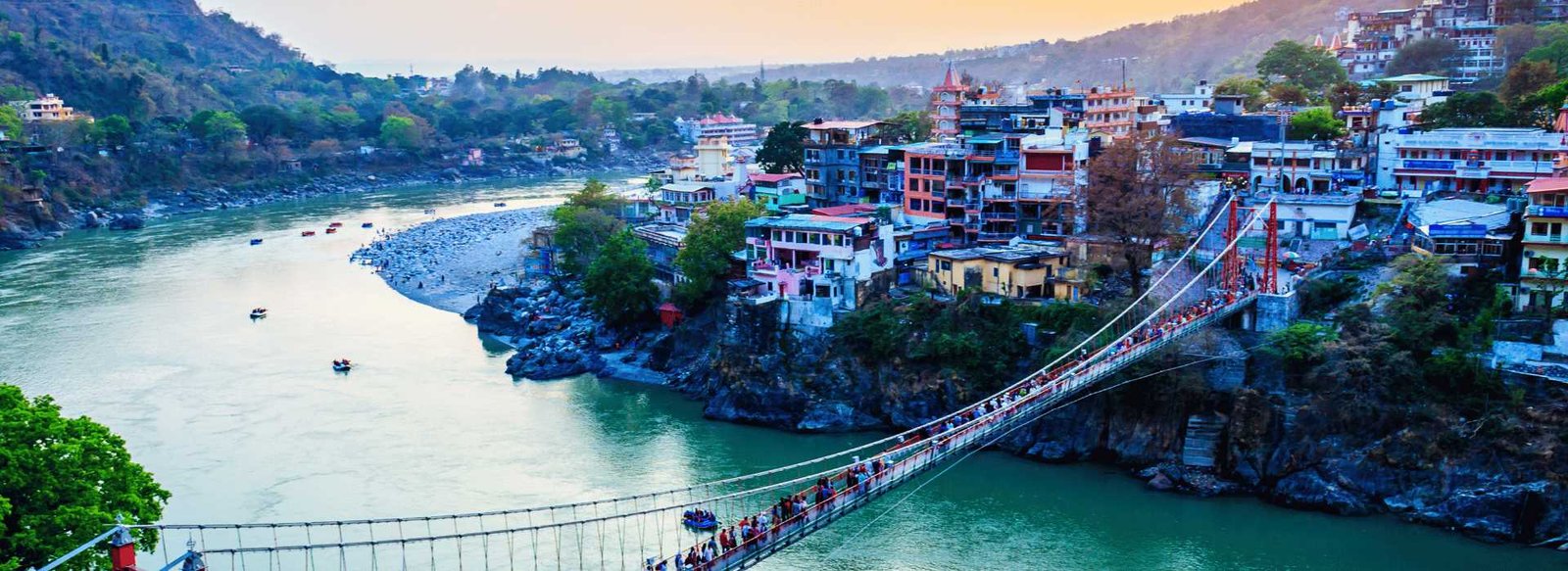
Located in the foothills of the Himalayas along the convergence of Ganga and Chandrabhaga River, Rishikesh is a small town in the Dehradun district, located close to Haridwar in Uttarakhand. Rishikesh (also called as Hrishikesh) is known for its adventure activities, ancient temples, popular cafes and as the “Yoga Capital of the World”. Gateway to Garhwal Himalayas, Rishikesh is also a pilgrimage town and one of the holiest places for Hindus.
Rishikesh became known worldwide in the 1960s after The Beatles visited the ashram of Maharishi Mahesh Yogi here. Today, the place is popular as The Beatles Ashram which beckons tourists globally. The tranquil town has long been a spiritual centre but is equally popular for the whitewater rafting, bungee jumping, mountain biking and camping along the fast-flowing Holy Ganges. It also serves as the gateway to many Himalayan treks.
Rishikesh is divided into two main areas – the downtown area known as Rishikesh town which is where the popular Triveni Ghat is situated. 2 km upstream from the popular Ram Jhula and Lakshman Jhula is the other side of Rishikesh where most of the popular ashrams, cafes, accommodation and tourists can be found. Haridwar and Rishikesh are the first Indian cities to be given the title of “twin national heritage cities”.
Rafting
Rafting in Rishikesh particularly is hands down the best; one could endeavour in India. From the gifted natural circumstances to the top professional assistance, the place has just the best to offer. There are some certified operators, whose safety arrangements are well in place, and there are customised packages for camping and rafting at Rishikesh. Your food, water and rafting arrangements are taken care of by operators if you want a stress free outing. If you want to look into matters yourself, you can also make your arrangements while you’re there. The peak season sees Rishikesh pretty crowded, so you can keep a check over that detail when you are planning.

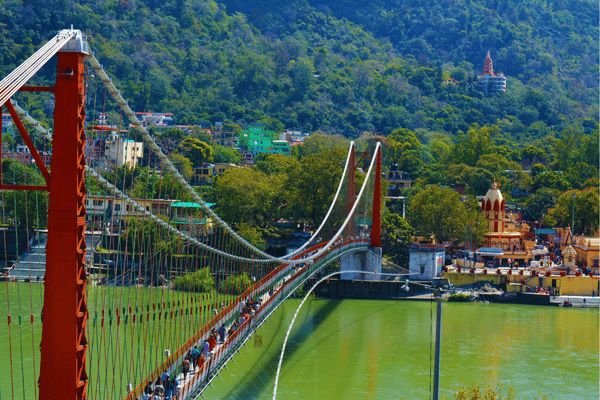

Lakshman Jhula
The Lakshman Jhula is a famous hanging bridge across the river Ganga that connects two villages, Tapovan in the Tehri Garhwal district and Jonk in the Pauri Garhwal district. Located 5 kilometres to the northeast of the town Rishikesh in the Indian state of Uttarakhand, the entire bridge is made up of iron, is 450 feet long and is situated at the height of 70 feet from the river. The Lakshman Jhula is well-known amongst tourists because it is believed that Lord Lakshman, the younger brother of Lord Rama, had crossed the river Ganga at this same site, where the bridge now majestically stands for all to see.
The construction of the bridge was completed in the year 1929, and presently, the Lakshman Jhula acts as an adjoining bridge across the river, along with the old route to the sacred shrines of Badrinath and Kedarnath. In the present day scenario, the Lakshman Jhula is visited by thousands of tourists each year. Grand temples and famous markets have sprung up in the vicinity, and the entire area is a now a particularly renowned attraction in entire Rishikesh.
Important places around the Lakshman Jhula include the Terah Manzil temple, the Lakshman temple, and the Ram Jhula and the entire area resonates with the sounds of the enchanting mantras and shlokas from the temple.
Triveni Ghat
Situated on the banks of the holy river Ganges, Triveni Ghat is the biggest ghat in Rishikesh. ‘Maha Aarti’ happens every evening at Triveni Ghat.
Triveni Ghat plays an essential role in Hindu Mythology and is also mentioned in the epics Ramayan and Mahabharat. The Triveni Ghat is also where the chattri of Lord Krishna was constructed. In fact, the ghat is considered to be the cremation ground for the great Lord Krishna. Along with the holy dips, the devotees also make offerings to the river in the form of milk, while feeding the fishes in the Ghat too.
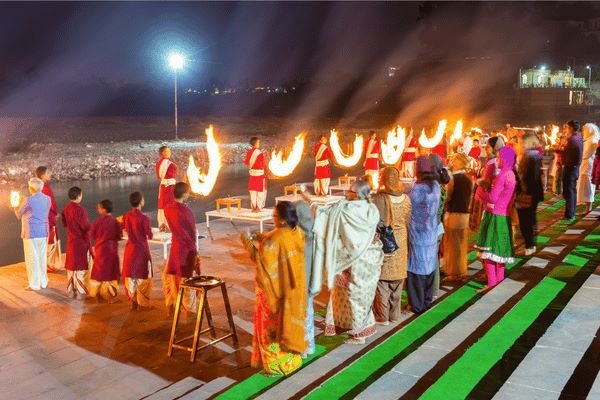
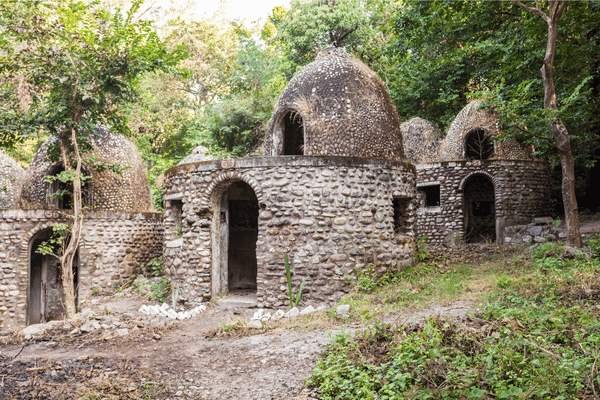
The Beatles Ashram
Initially known as Maharishi Mahesh Yogi Ashram, the Beatles Ashram was named so after the Beatles visited the ashram in 1968 to get trained on the advanced techniques of Transcendental Meditation. The ashram is now an eco-friendly tourist attraction located in the Rajaji National Park and offers a serene ambience located close to the mesmerising River Ganga. It is one of the attractions that is sure to take one close to nature. People, therefore, visit the attraction for soothing nature walks, trekking and bird watching sessions too.
Ganga Aarti
Ganga Aarti is the most auspicious and holiest ritual performed on the ghats of Rishikesh in the evening at the time of dusk. Considered to be a major source of tourism boost in the river town, the ceremony is a grand affair. The river bank is lit up with dainty floating diyas and the smoke of the hawans floating the skies. The chiming of the temple bells, the chanting of mantras and the overall ambiance of the place is an experience of a lifetime. Besides being a soulful and peaceful experience, the rituals offers an insight into the Hindu culture.
Although the aarti is performed at several ghats, the most popular ones are performed at Parmath Niketan Ghat and Triveni Ghat. It is performed by Vedic priests, basically students who are studying the Vedas. The prayers are made to Agni – the God of Fire, and the saffron clad pandits hold large bowls of fire which go round and round in front of the river bank. You can either sit as a spectator and enjoy the ambiance from afar or participate in chanting the bhajans and performing the aarti yourself. Pilgrims also offer flowers to the gods that float in the waters along with the diyas.

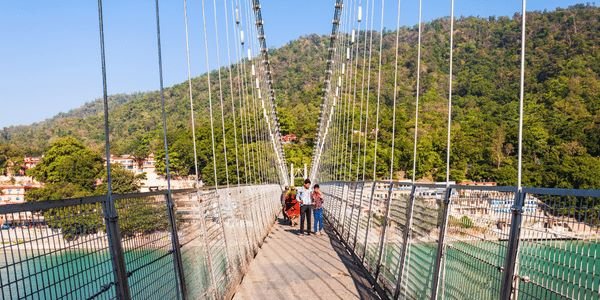
Ram Jhula
An iconic landmark, Ram Jhula, built in 1986, is a suspension bridge that runs across the sacred River Ganga connecting Shivananda Nagar to Swargashram. The bridge spans 750 feet and is a splendid work of engineering that connects the religious ashrams situated on both sides of the river and offers a splendid bird’s eye view of the mighty Ganges and the serene nature at the foothills of the Himalayas.
Shivpuri
Shivpuri is a picturesque town located on the foothills of the Himalayas. It has a thrilling rafting stretch amidst beautiful natural surroundings and is, therefore, famous for River Rafting. The town is often referred to as the River Rafting destination in India. It also has a number of camps that draw tourists pretty often for a weekend getaway from nearby cities.
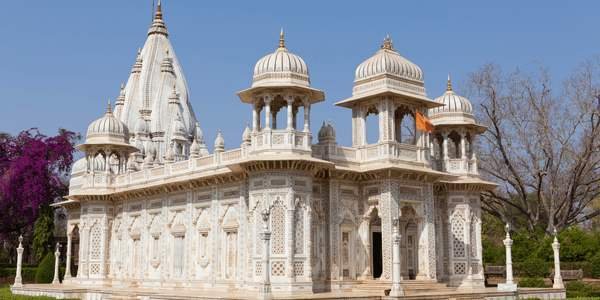
Mussorie
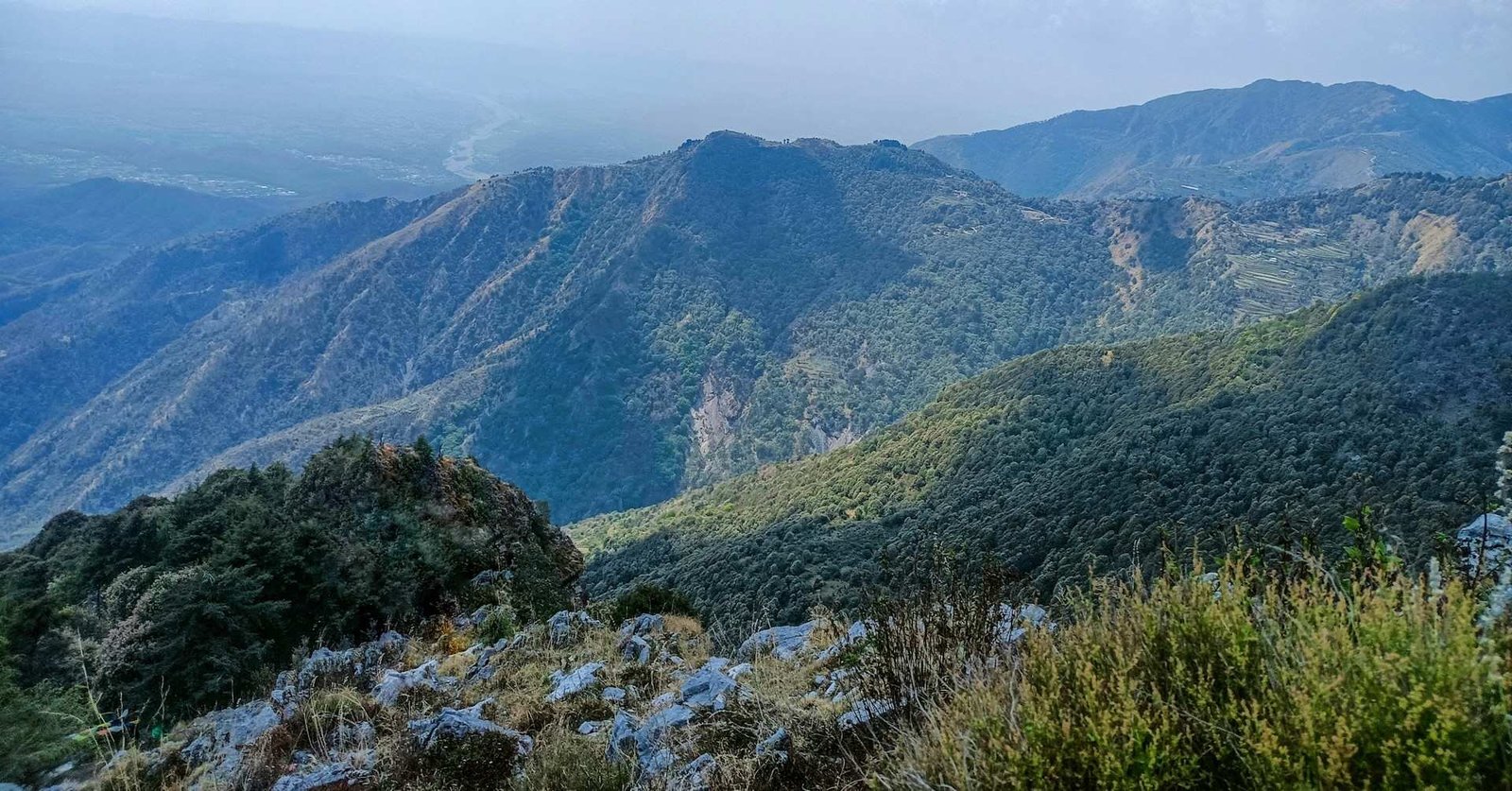
Mussoorie is one of the most popular hill stations located at a distance of 290 km from Delhi in Dehradun district of Uttarakhand. With a backdrop of Shivalik range of Himalayas and doon valley, Mussoorie, also known as Queen of The Hills, stands at an altitude of 7000 feet above sea level and has a cool, pleasant climate throughout the year. Once the British summer capital, Mussoorie is a popular getaway for honeymooners and families.
Lal Tibba
Lal Tibba is a popular viewpoint, located on the top of Depot Hill in Landour, approximately 6 kilometres from Mussoorie. Being the highest point in the area, Lal Tibba is one of the most stunning viewpoints in the region. Rising to a height of 2,275 meters (7,164 feet), Lal Tibba affords breathtaking views of Nilkantha peak (6,596 meters) in Badrinath, Kedarnath peak (6,940 meters), up to Banderpoonch range of three peaks with the highest rising to 6,316 meters. It is also a popular sunrise and sunset point.
The Lal Tibba region has long been occupied, serving as a summer getaway during the British-Raj and a recovering station for the military, hence gaining popularity as a cantonment cum hill station. It is now occupied by the Indian Military Services. In the form of a small terrace, La Tibba has mesmerizing views of the Tibet border. The place is relaxing and has remains of British Architecture.
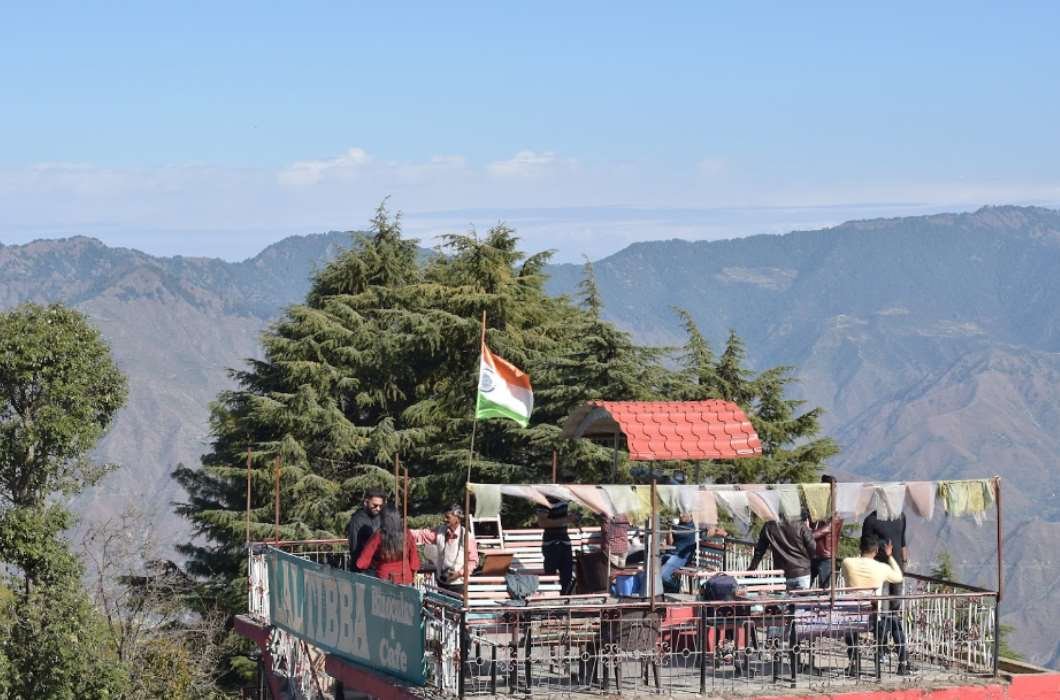
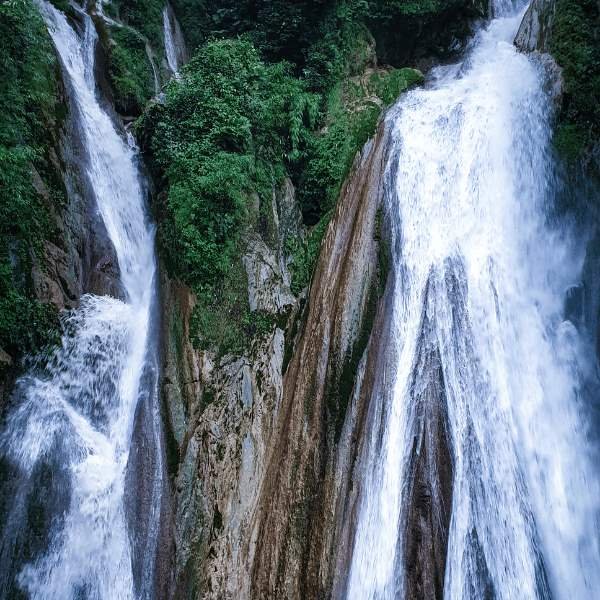
Kempty Falls
Located on the way between Dehradun–Mussoorie roads, in the Ram Gaon area of Tehri Garhwal, Kempty Falls is one the most popular tourist attraction and picnic spot in Mussoorie. Surrounded by high mountain cliffs, Kempty Falls is nestled at an altitude of around 4500 ft above the sea level. The pond formed at the bottom of the falls makes an excellent spot for swimming and bathing.
The name of Kempty Falls is taken from the terms “camp and tea” implying the elaborate tea parties that were once organized here in evenings eventually leading to a localized name Kempty. It was developed as a picnic destination by John Mekinan owing to its captivating surroundings and scenic beauty. Offering a stunning view of water stream cascading down from a great height, it divides into two main falls. Quite famous among the tourists as a picnic spot, the perennial Kempty waterfall is crowded almost throughout the year.
Gun Hills
Said to be an extinct volcano, the Gun Hill is the second-highest point in Mussoorie, situated at an altitude of 2024 meters. The scene from the top of this hill is a panoramic view of the snow-clad Himalayan ranges right beside the widespread Doon Valley and a full view of the hill station of Mussoorie. The Gun Hill, located 400 ft above the Mall Road, is a popular attraction, especially amongst the photographers and nature lovers.
The highlight of Gun Hill is the ropeway which provides a scenic view of the Himalayan ranges. The hill was named so because of the presence of a gun at these hills during the pre-independence days. The gun was fired during the day to enable people to adjust their watches during those days.
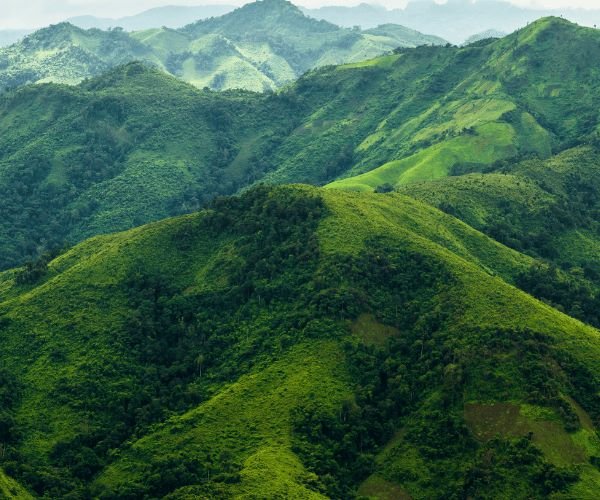
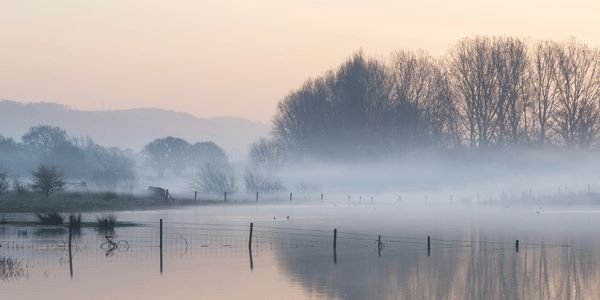
Lake Mist
The pristine Lake Mist is among the most beautiful destinations in the Queen of Hills i.e. Mussoorie. The emerald waters are covered by green forest terrains from sides giving the whole scenario a resplendent image making it an ideal for spending the moments of repose with your family and friends. Lake Mist falls on the way to Kempty Falls. The major highlight of this scenic lake is the less crowded, hence, you can enjoy the calmness in the laps of nature. It is a gem of attraction.
Cloud’s End
6 km west off the Library, the Cloud’s End viewpoint marks the geographical end of the beautiful hilltown of Mussoorie. Surrounded by thick oak and deodar forests, it tracks 2 km up to the Benog Wildlife Sanctuary offering a lovely walking track, taking in the soothing mountain air. Cloud’s End is visited for the breathtaking views it offers, especially of the Aglar River Valley.
Another major attraction at Cloud’s End is a heritage building set up by a Britisher in 1838, which is one of the oldest buildings in Mussoorie. Retaining the original architecture and other relics, it has now been converted into a heritage hotel (Clouds End Forest Resort). Tourists spend some tranquil time during their stay, along with partaking in activities like hiking, hill climbing and nature walks arranged by the hotel on request. People often club the visit to Cloud’s End with the famous attractions nearby – Jwala Devi Temple and Benong Wildlife Sanctuary.
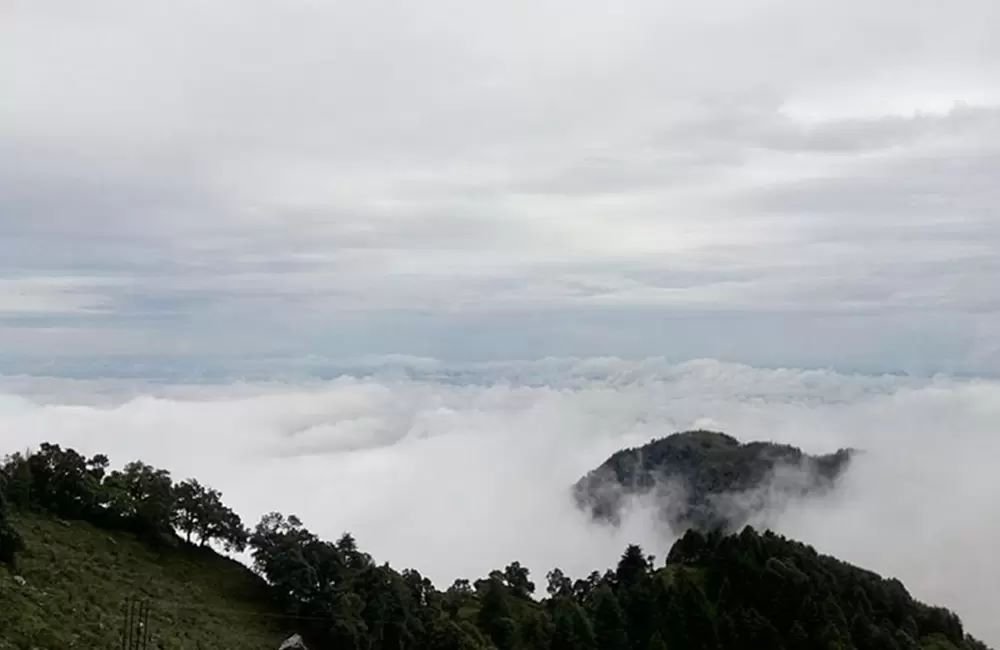
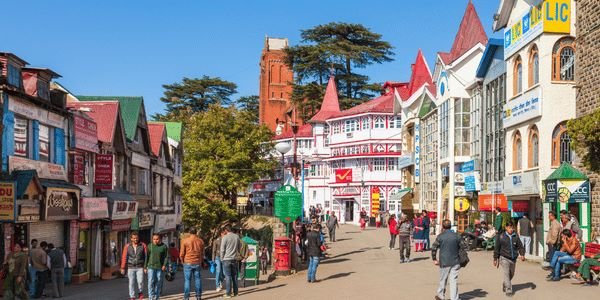
The Mall Road
Located in the heart of Mussoorie, the Mall is a colonial relic with benches and lampposts filled with modern shops, video game parlours and skating rinks. You can often find the author Ruskin Bond browsing the Cambridge Bookstore. There would be a lot of local vendors around including photographers who can click awesome photographs for you. Do try out a photograph in local traditional attire here.
Jim Corbett National Park
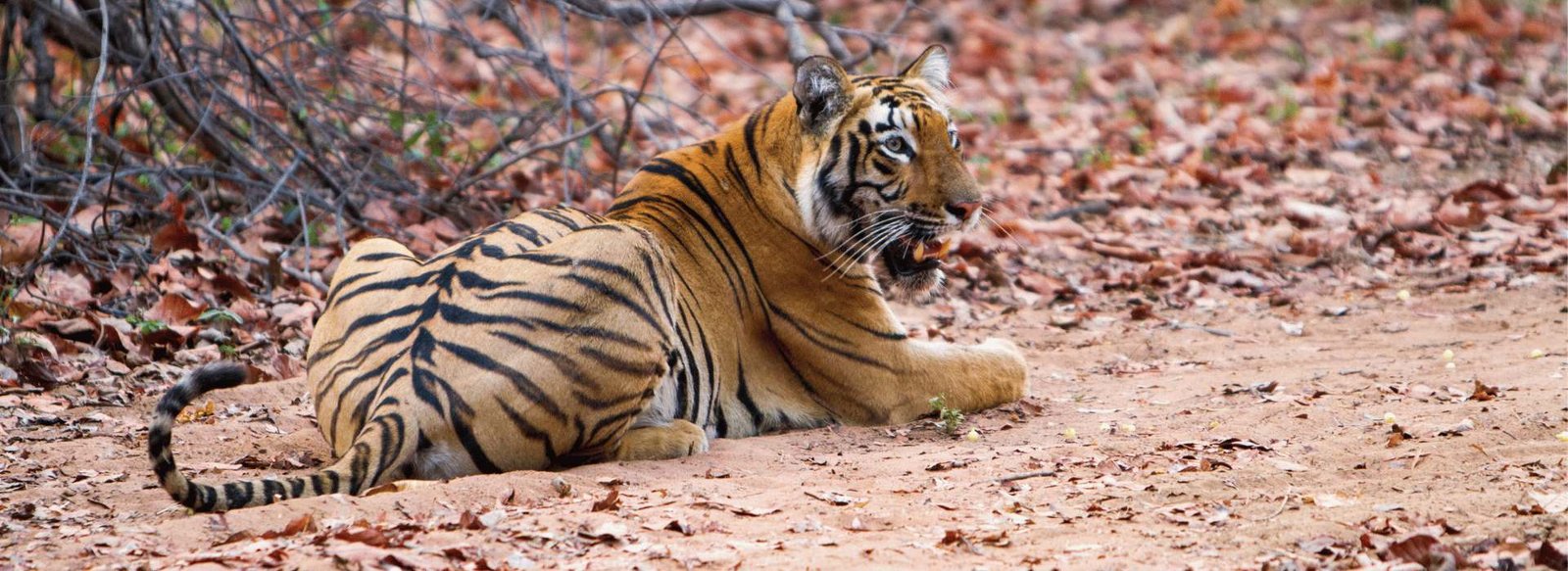
Jim Corbett National Park is the oldest national park in India known for housing the endangered Bengal tiger. Corbett National Park is part of the larger Corbett Tiger Reserve which is set amidst the foothills of the Himalayas in the Nainital district of Uttarakhand. It houses a variety of flora and fauna including rare ones such as tigers and is a treat for wildlife enthusiasts and photographers.
Famous for its wildlife safaris, Jim Corbett National Park is one of the few tiger reserves in India which allows overnight stays. Home to more than 650 species of rare and migratory birds, it is a haven for bird watchers. The most popular attraction at Corbett National Park is Dhikala, a forest lodge located on the border of Patil Dun Valley, which is known for the stunning location and rich wildlife. The Jim Corbett National Park was established in 1936 as Hailey National Park and is named after Jim Corbett who is a famous hunter and naturalist. It was the first place where Project Tiger was launched in 1973. The park is spread over an area of more than 500 sq km and is divided into 5 zones: Bijrani, Dhikala, Jhirna, Domunda and Sonanandi to promote tourism.
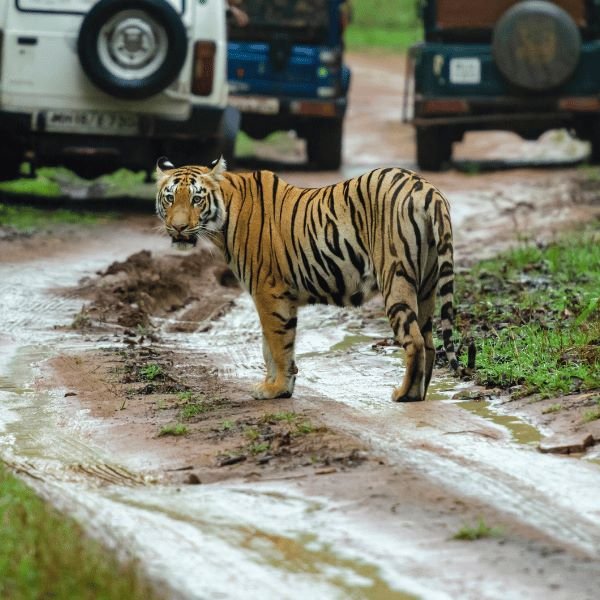
Jungle Safari
The jungle safaris at Jim Corbett are organised once in the morning and in the evening. Divided into five tourism zones, each zone has a restriction on the number of vehicles allowed within at a given point in time. There are two types of safaris at Jim Corbett National Park – Jeep Safari and Canter Safari.
The Canter Safari is only available for the Dhikala zone, the core area of the park. The likelihood of spotting the famed Bengal tiger is highest in this region. Apart from the canter safari, only those visitors staying at the forest lodge in the Dhikala zone are permitted to explore the area through a jeep safari. The Jeep Safari is the most popular safari choice at the park and is an available option to explore four out of the five zones at the reserve, with the exception being the Dhikala zone. There is a maximum of 6 people allowed per jeep, and the number of jeeps in each zone cannot cross a certain limit at any given point in time. This limit varies from region to region.
River Rafting
River rafting in the Kosi River at Corbett National Park is one of the most beautiful ways to enjoy its speedy waters, taking you through Class II & III rapids. This activity is meant for all – beginners or professionals. River rafting in Jim Corbett can be done only during the monsoons. The best time for river rafting in Kosi river is from July to September. Other adventure water sports like fishing, angling and rappelling are also organized on the river.
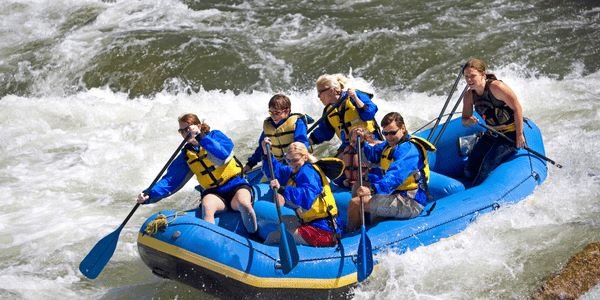
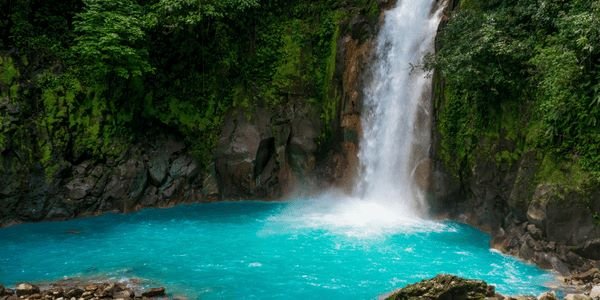
Corbett Waterfall
Corbett Falls is a beautiful waterfall, located 25 km away from Ramnagar in Kaladhungi. Surrounded by dense forests and offering a very serene environment, this 66 ft. high waterfall is a sight to witness, especially on full-moon nights. Nature lovers often camp and come on a picnic near this waterfall. A short 2km trek leads to Corbett Waterfalls.
Haridwar
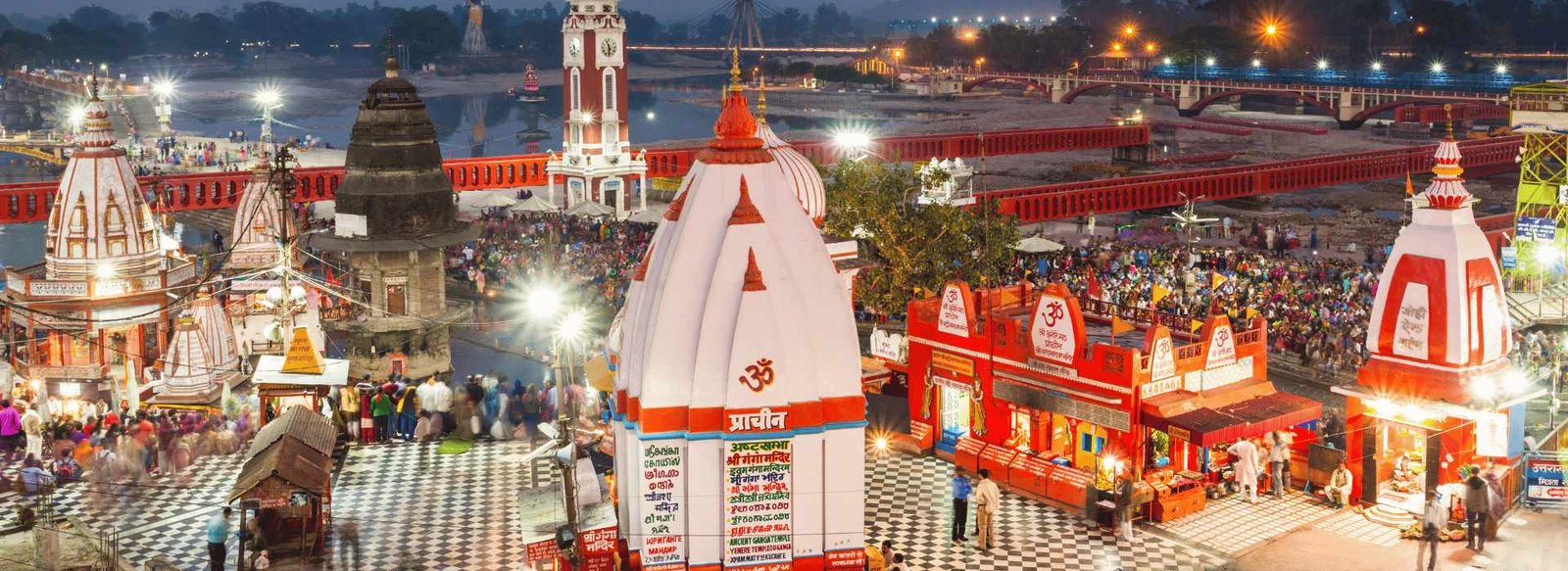
Haridwar, considered to be among the seven holiest cities in India, is an ancient city located on the banks of River Ganga in the Garhwal region of Uttarakhand. Dotted with temples, ashrams and narrow lanes across the city, Haridwar is a famous Hindu temple town where millions of devotees come to take a dip in the holy Ganges. It’s believed that taking a dip in the holy Har Ki Pauri relieves you of all your sins.
Every evening, Haridwar is witness to a set of rituals for the famous Ganga Aarti at the Ghats (River Banks) where thousands of devotees come together to pray to the river. Once in every twelve years, Haridwar is host to the mega-gathering during the world famous Kumbh Mela which sees millions of visitors from all over the country. Along with Prayagraj, Nashik and Ujjain, Haridwar is one of the only four cities in India which can host the Kumbh Mela.
Ganga Aarti
Ganga Aarti is a religious prayer that takes place at the bank of the sacred river Ganga at the Har Ki Pauri ghat in Haridwar. Bringing in tourists and devotees from all over the world, it is a ritual of light and sound where the priests perform prayers with bowls of fire and the ringing of the temple bells. Visitors float “diyas” (small candles) and flowers, surrounded by the chanting of the mantras and the reflection of the lights off the surface of the flowing river, which is said to be blessed by the Goddess.
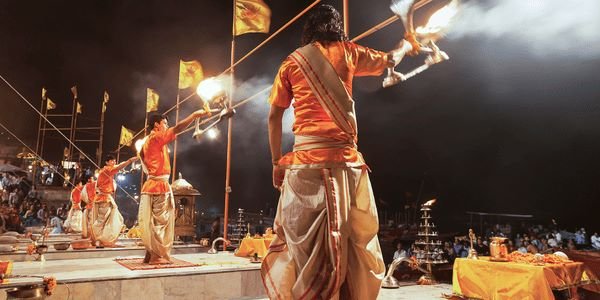
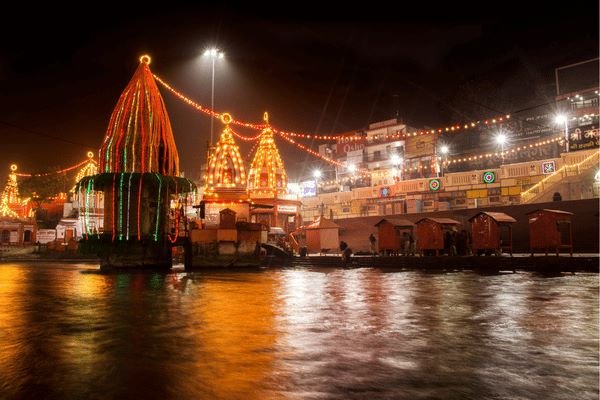
Har ki Pauri
Har Ki Paudi is the place where River Ganga flowing through the Himalayas touches the plains for the first time. Oozing serenity and calm all the time, it is the evening time at Har Ki Pauri that is most cherished by its visitors. With a plethora of temples at the river bank, offerings are made with lighted candles and diyas floating across the river, an enchanting sight to behold. The chanting of mantras and prayers with sages meditating exudes spiritual vibes and is an experience of a lifetime. The sound of gongs in the background takes one to an entirely different world. Lord Shiva and Lord Vishnu are believed to have visited the place in Vedic times. The large footprints on a stone wall are said to belong to Lord Vishnu.
Chanda Devi Temple
The Chandi Devi Temple of Haridwar is a charming temple dedicated to the Chanda Devi Goddess, perched on the Neel Parvat of the Shivalik Hills. The Chandi Devi Mandir, also known as Neel Parvat Teerth, is one of the five pilgrimages of Haridwar and is also known as Siddha Peetha, a place where devotees worship to fulfil their desire. Because of its location, the Chandi Devi temple is also a preferred choice for trekking tourists. You can also reach the temple zenith by the means of a ropeway, the view from which is exhilarating.
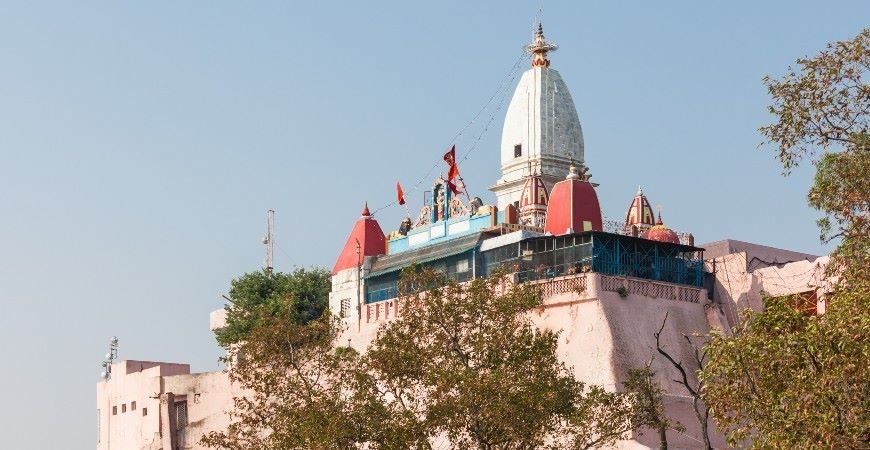
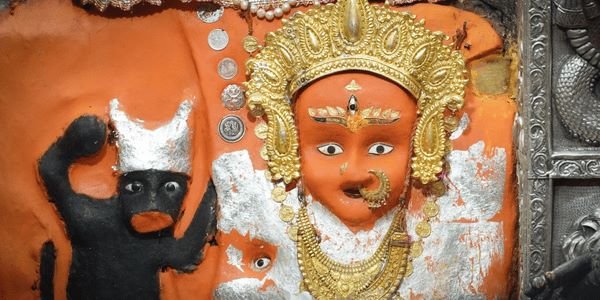
Mansa Devi Temple
The Mansa Devi Temple is a famous temple in Haridwar in Uttarakhand that is dedicated to the goddess Mansa Devi, who is considered to be a form of Shakti and is believed to have emerged from Lord Shiva’s mind. Thousands of Hindus flock to the temple every year in large numbers to this temple, which is one of the ‘Panch Tirths’ or the five pilgrimages in Haridwar. The temple is also popularly known as Bilwa Tirth and is perched on the top of the Bilwa Parvat on the Sivalik Hills.
Bharat Mata Mandir
The Bharat Mata Mandir in Haridwar is dedicated to India as a country and thereby gets its name from its purpose. Its name translates into “The Moth India Temple”. The multi-storey temple situated in Sapt Sarovar is not a temple that worships gods or has any religious inclination, but one that stands for the many freedom fighters and patriots of the Indian Struggle for Independence. The majestic temple Bharat Mata Mandir also celebrates the unique trait of India and its immense culture. The oneness of the country and its diversity are also a few aspects that the Bharat Mata Mandir brings to our attention. The late Indian Prime Minister Indira Gandhi inaugurated the Bharat Mata Temple in 1983. The temple stands at a height of 180 feet and has a total of 8 floors with a specific theme. The temple has a massive map of the Mother India on the ground, denoting the statue of the mother of India depicted as a four-armed Hindu goddess wearing saffron-coloured robes, holding a book, sheaves of rice, a mala, and a white cloth.
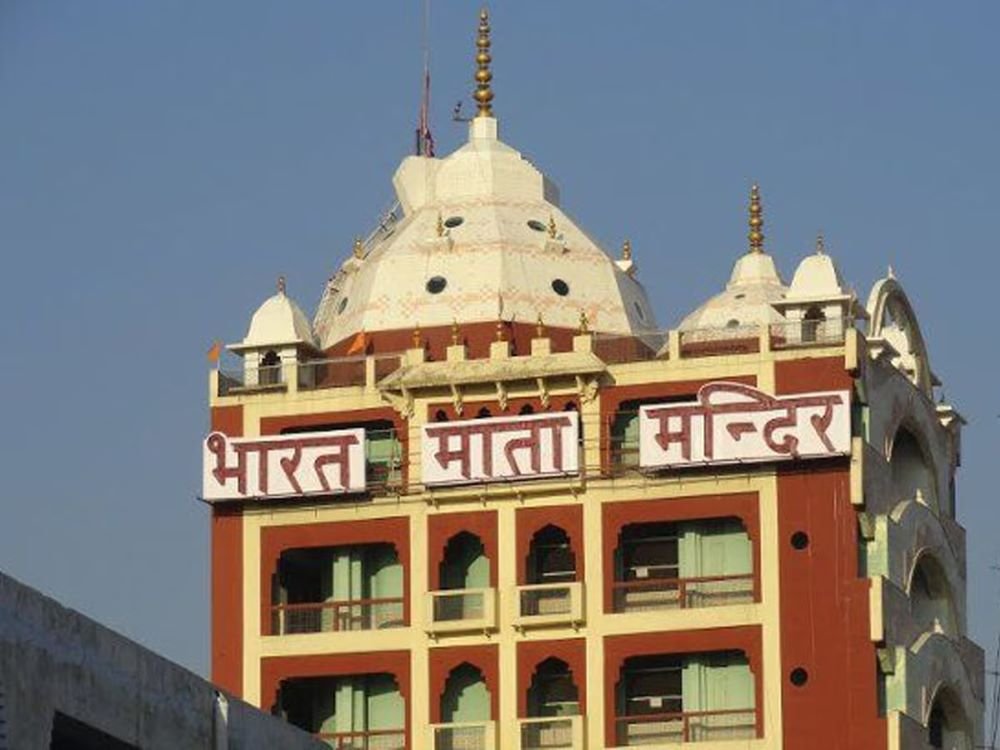

Bharat Mata Mandir
The Bharat Mata Mandir in Haridwar is dedicated to India as a country and thereby gets its name from its purpose. Its name translates into “The Moth India Temple”. The multi-storey temple situated in Sapt Sarovar is not a temple that worships gods or has any religious inclination, but one that stands for the many freedom fighters and patriots of the Indian Struggle for Independence. The majestic temple Bharat Mata Mandir also celebrates the unique trait of India and its immense culture. The oneness of the country and its diversity are also a few aspects that the Bharat Mata Mandir brings to our attention. The late Indian Prime Minister Indira Gandhi inaugurated the Bharat Mata Temple in 1983. The temple stands at a height of 180 feet and has a total of 8 floors with a specific theme. The temple has a massive map of the Mother India on the ground, denoting the statue of the mother of India depicted as a four-armed Hindu goddess wearing saffron-coloured robes, holding a book, sheaves of rice, a mala, and a white cloth.
Dehradun
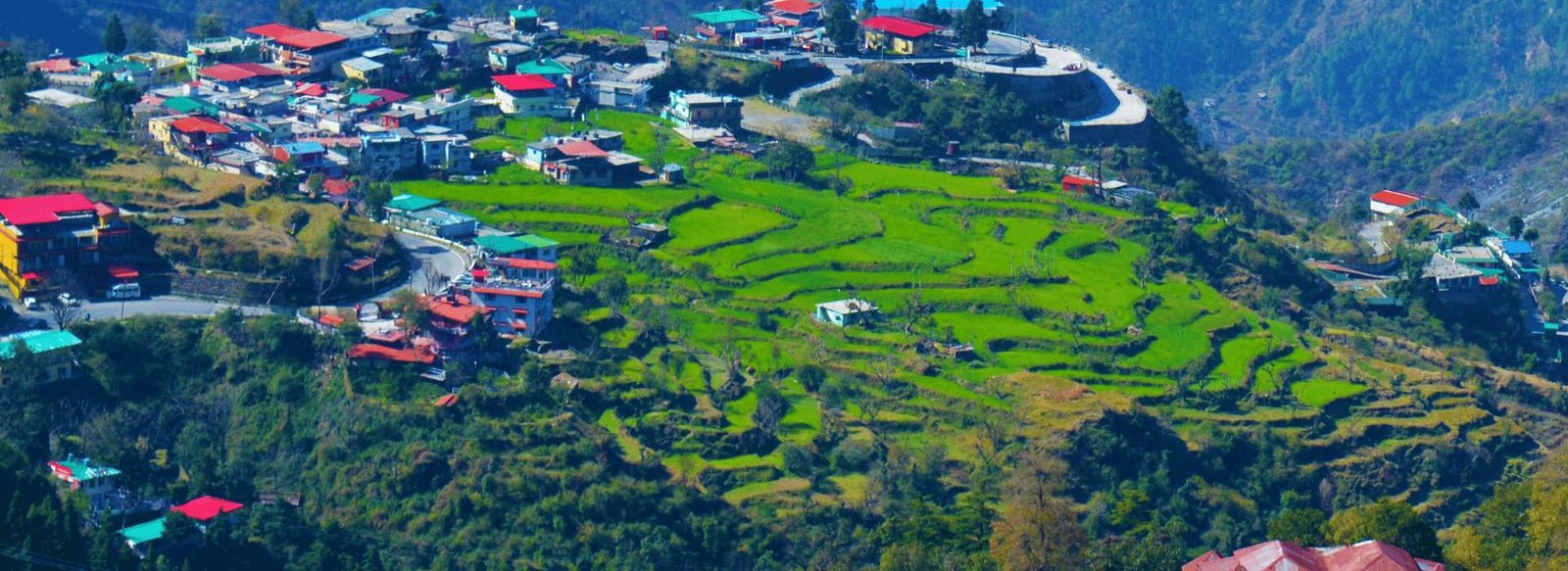
Nestled amidst the Doon Valley in the state of Uttarakhand, Dehradun city is a very popular hill station that beckons solo travellers, families and couples alike. Winter Capital of Uttarakhand, it proudly boasts of a scenic backdrop of the Garhwal Himalayas. Dehradun is located at an altitude of 1400 feet above sea level and has a pleasant climate all year round. Regardless of whether you want to explore family-friendly tourist spots, try thrilling adventure activities with your friends, or watch a mesmerizing sunset with your partner amidst the mountains, Dehradun is the answer.
Har ki Dun
Nestled away from the hustle bustle of the city, Har Ki dun is a beautiful cradle shaped valley with untouched panoramic beauty. Perched at an elevation of 3,566 mts above the sea level, this place is one of the remotest areas of Uttarakhand offering a plethora of trekking excursions. Also referred to as “Valley of Gods”, in Har Ki Dun you will find yourself surrounded by thick Pine forests and scintillating mountain peaks. This beautiful trail will take you to some of the most unexplored areas of Garhwal Himalayan region where the simplicity and rustic lifestyle of the residents of hills is still untouched by the time. The beautifully carved houses along the way add to the cha

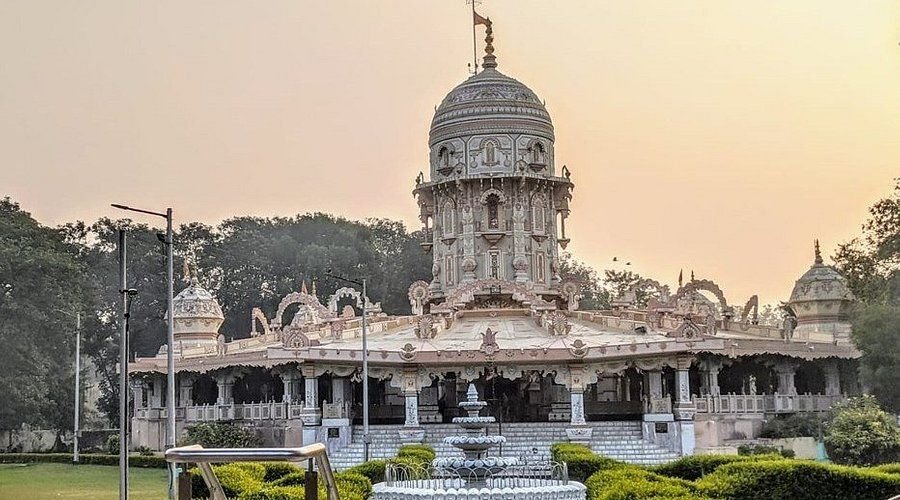
Tapovan Temple
Situated on the banks of the river Ganga, Tapovan is a holy place which is located at a distance of 5 km from the Dehradun city. Due to the history of the Ashram, devotees flock to the place frequently in the quest to find inner peace. All sorts of holy Hindu rituals are performed at the ashram. The ashram also conducts yoga courses for those interested ones. Surrounded by greenery visit to this temple is known for releasing the tension and providing a sense of satisfaction as well as peace of mind to the visitors. It is a very famous place to go for meditation and yoga. Interestingly, the word “Tapovan” has been derived from two words- Tapasya which means rigour and van which means forest. Owing to its great weather all year, the place is visited by tourists at all times.
Lachiwalla
Lacchiwalla is a popular picnic destination near Dehradun. Located in the forest area of Rajaji, Lacchiwalla is famous for its greenery, picturesque cottages and hotels. The beauty of the place is heightened by the brook, flowing through the forest area. The brook serves as a natural water park where people can get engaged in all sorts of water activities such as swimming, boating, etc. However, one must remember to carry one’s swimming equipment as the authorities do not provide anything as such. The place is especially popular among families to hang out on weekends. It also has a garden with several monkeys menacingly hanging around and about the trees.

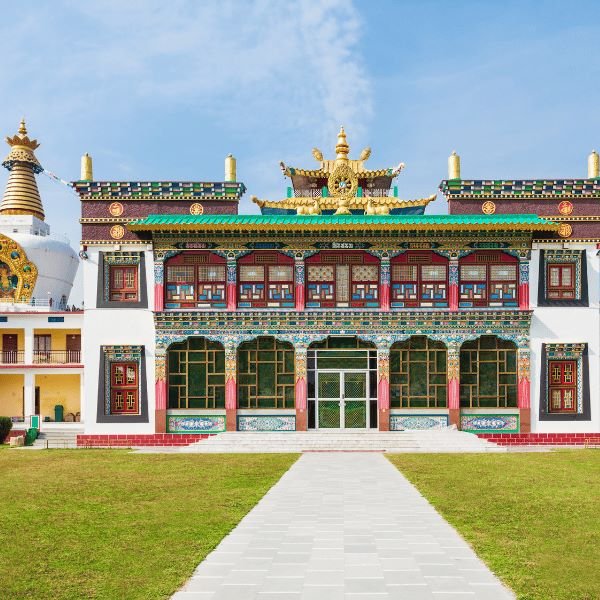
Mindrolling Monastery
The Mindrolling Monastery, also known as the Buddha Temple Complex, was established in Clement Town, Dehradun, Uttarakhand by Khochhen Rinpoche in 1965. Situated in the middle of the serene foothills of the Himalayas, the Mindrolling Monastery is one of the largest Buddhist centres in India which attracts thousands of visitors from all over the country as well as abroad. Hundreds of individuals attain spirituality here on a daily basis.
Being an architectural masterpiece with several sections, the monastery is a visual wonder. The monastery exudes beauty owing to its gardens, university complex and the tallest Stupa in Asia. While surrounded by greenery, it also has numerous shrine rooms, Tibetan art forms, and murals. What catches the attention of every tourist is the presence of the tall statue of Lord Buddha. This beautiful place should definitely be visited if you are planning a trip to Dehradun.
Robber’s Cave
Robber’s Cave, locally known as Gucchu Pani, is a river cave formed in the Himalayas, about 8 kilometres from Dehradun, Uttarakhand. This river cave is believed to be an abode of Lord Shiva and is very close to Sahasradhara or ‘The Thousandfold Springs’ in Uttarakhand. Its speciality is that river water flows out from the middle of the cave. The cave is a narrow gorge formed between a conglomerate limestone formation. It creates a feeling similar to being in a scene from a mystery movie – surrounded by dark limestone as streams gush in, echoing inside the cave. If not this, it definitely promises a sense of belongingness as Mother Nature slows you down, making you resonate with its mesmerising beauty.
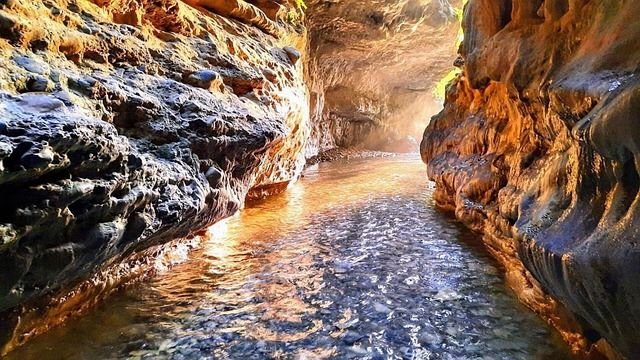
Lansdowne

Lansdowne is a quaint little hill town located at a distance of 258 km from Delhi in Pauri district of Uttarakhand. Laden with oak and pine forest and dotted with buildings of the colonial era, this hill station is a haven for bird watchers, casual hikers and weekenders from NCR. The town was discovered by British and got its name from the then Viceroy of India, Lord Lansdowne. The guesthouses here are fading reminders of the colonial period, and they offer a stunning view of the mountains from their balconies.
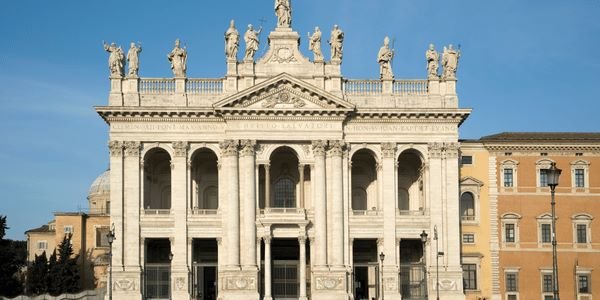
St. John’s Church
Located at the Mall Road this Catholic Church was built in 1936. The beautiful interiors and green surroundings of the church attract tourists and make it a must visit destination.
Jungle Safari
If you would like to explore the wilderness of Lansdowne, many tour operators organize jungle safaris into the heart of the forests where you can catch a glimpse of Himalayan wild animals in their natural habitat.
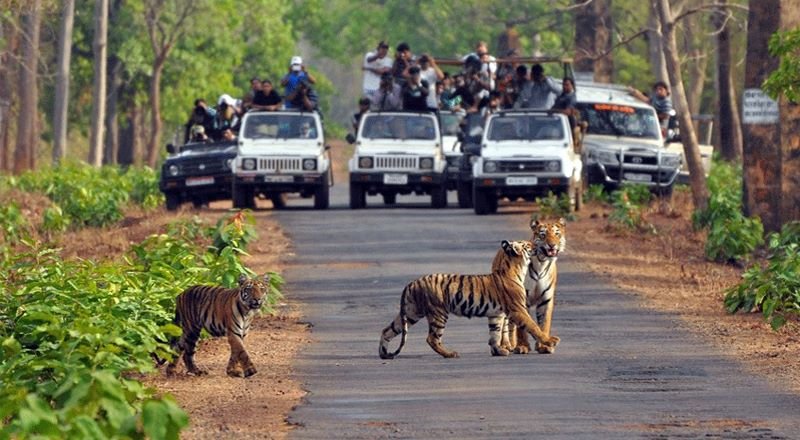

Tip N Top
Tip N Top, also commonly known as Tiffin Top, is a small hilltop viewpoint that is located at 1700 metres above the sea level and provides visitors with magnificent, breathtaking views. This famous attraction is located just 1. 5 kilometres away from the main city of Lansdowne and is the centre of attraction of the entire region. The name itself suggests that the place is the highest point in all of Lansdowne, and the attraction is like heaven reincarnate on Earth. It provides visitors with splendid panoramic sights not only of the entire city but also of the nearby-forested area, and the Garhwal Hills with the majestic Himalayan range in the background. Imagine waking up to see the complete skyline and Shivalik Range in front of your eyes: the Tiffin Top offers precisely that.
Bhulla Lake
One of the most favourite picnic spots among locals and tourists, Bhulla Lake is a well-maintained serene lake made and maintained by Indian Army. Bhulla Lake is loved for its tranquil atmosphere, as it is not much populated and there are ample boating facilities available here.
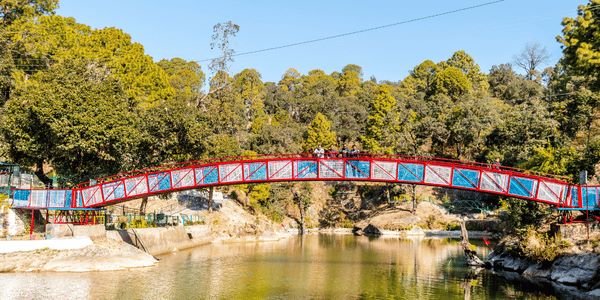
Rajaji’s National park

Encompassing the Shivalik mountain ranges, Rajaji National Park is abundantly rich in flora and fauna and proves a great holiday destination for nature lovers and wildlife enthusiasts alike. One can spot many birds including many species of migratory birds, especially after monsoons.
Famous for its wildlife, especially for tigers and elephants, Rajaji National Park has recently received the status of a Tiger Reserve by the Government of India. Named in the honour or C. Rajagopalchari, this national park spreads over 3 districts of Uttarakhand including Dehradun, Haridwar and Pauri Garhwal. This area is also enriched with valuable fossils which date back to as old as 10 million years old. The forest area is popular for Sal, Teak and other shrubs. You should explore the wilderness and rich diversity of Himalayan lives here with a Jeep Safari or Elephant Safari organised by the Forest Department, the 34 km jungle track is a major attraction here. You can spot Asian Elephants, Tiger and King Cobra, Panther, Bear, Chital, Sambar, Wild Boar, Kakar, Python, Monitor Lizard, Wild Cats.

